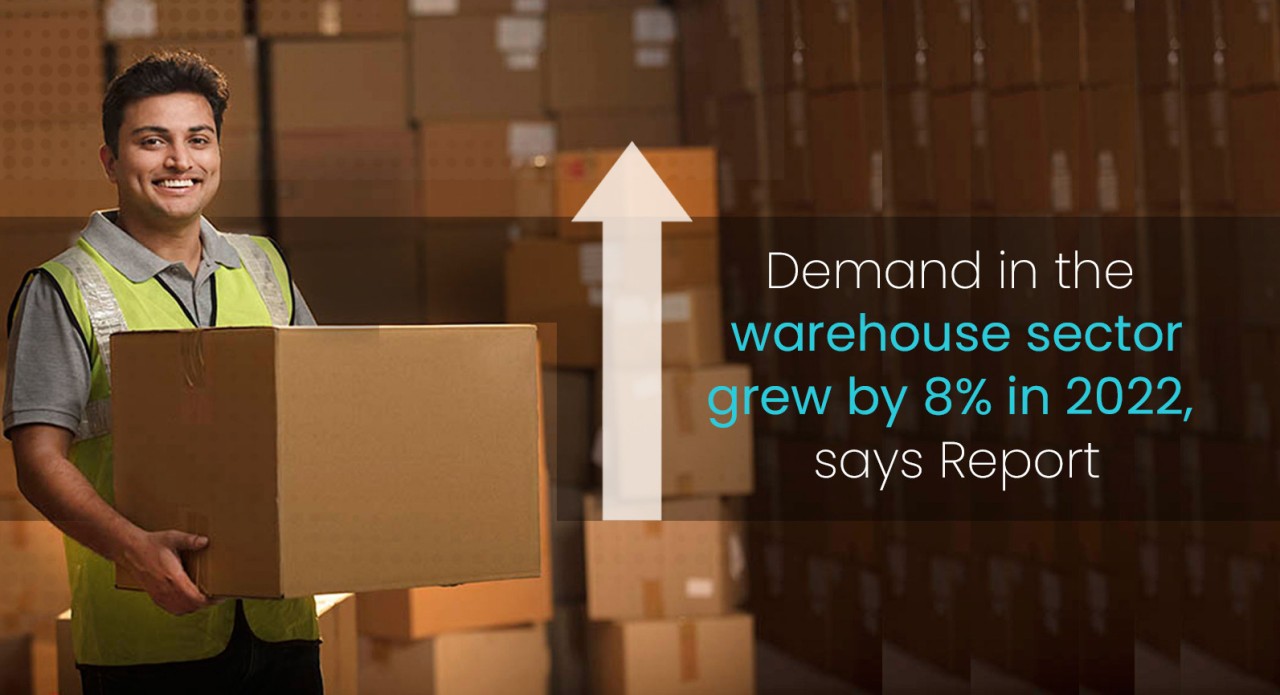
Demand in the warehouse sector grew by 8% in 2022, says Report
The post-pandemic boom in online sales and a change in consumers’ purchasing habits have been the key drivers of this sector’s transition in India. A number of technology advancements as well as newer, more adaptable business models that take into account various operational and cost-related elements have been made possible by evolving business requirements and changing consumer behavior.
Consumers have turned to online shopping as a result of this emphasis on convenience and speed. On the other hand, the commercial and office sectors have seen changes in the shape of flexible office spaces and smaller sizes that are closer to customer locations. With the rate of development in demand and the expansion of government backing in a number of areas, the industry may be in for rapid expansion.
According to the CREDAI-ANAROCK report ‘India Warehousing – A Sunrise Sector’, over the next three years, there will be a demand for over 223 million square feet of Grade A warehouse space. In order to aid such a level of development, an equity investment of about $3.8 billion will be required.
A large portion of this funding will need to go towards Grade A warehouses, which are in higher demand due to their favorable effects on overall operating efficiencies.
The report states that at a CAGR of 12.6%, Grade A warehousing increased from 34 million square feet in 2018 to 48.5 million square feet in 2021. With a CAGR of 10.6%, supply in this category increased during the same time period from 37.8 million square feet to 51 million square feet.
There were approximately 160+ million square feet of Grade A warehouse leasing in the top 7 Indian cities. The Western markets of Mumbai Metropolitan Region (MMR) and Pune experienced the most leasing activity, followed by Bangalore, Chennai, and Hyderabad, which together accounted for 32% of the total leasing volumes. MMR has the highest average rent among the top 7 cities, at INR 27 per square foot, and Hyderabad has the lowest, at INR 20 per square foot.
According to the Colliers Report, demand in the industrial and warehousing sector rose by 8% year-on-year across the top five cities in India in 2022. The average quarterly lease increased to 6.1 million square feet in 2018 from 5.7 million square feet in 2021.
With around 44% of the sector’s overall demand coming from 3PLs, they continued to be the largest users of storage space in 2022.
Due to the emphasis on businesses that cater to shifting consumer behaviour throughout India, the Indian logistics growth narrative is continuing to be resilient and is further proceeding on an accelerated growth trajectory.
This year, there will be a greater need for warehouse capacity due to the convenience of shopping/returns, increased UPI adoption, omnichannel retailing, etc. This will be especially true to increase last-mile connections in Tier I and Tier II cities.
The foundations for India’s industrial demand are still solid, and the government’s recently announced Production Linked Incentive (PLI) plans for key sectors are anticipated to further increase domestic production and fuel the demand for organized industrial spaces and warehousing facilities.
The “China plus one” plan is gathering momentum, and as part of its de-risking strategy, multinational corporations are eager to shift their production concentration to India. This is a major trend to look out for this year.
Engineering and electronics companies had a more than 2-fold increase in demand during 2022, and their market share increased from 13% in 2021 to 28%. When they expanded their activities across cities, around 70% of leases in engineering and electronics were large-sized deals (>1,000 sq ft). For these companies, Delhi-NCR and Pune were the top locations.
Demand was still strong in 2022, but supply was still constrained. Around 19 million square feet of fresh supply were added in 2022, a 20% YoY decrease. Although the cost of the building remained unpredictable throughout the year, developers took their time adding additional supplies. They continued to be circumspect and expected pre-commitments. As a result, there was a decrease in vacancy rates amid high demand. The overall vacancy rate was 9.4% at the end of the year, down 2.4pp.
Rental rates increased in 2022 in the major micro-markets thanks to a constrained new supply and strong demand. Rents are likely to firm up over the next few quarters since supply is likely to remain in control. But a lot would rely on how the business and economic climate developed. In the future, there will be more emphasis placed on sustainability and the use of technology to improve operational efficiency.
Conclusion
The Indian warehousing market constituted a value of INR 1,206.03 billion in 2021. Between 2022 and 2027, it is projected to increase at a CAGR of 15.64 per cent, reaching INR 2,872.10 billion. A record-breaking net absorption of 42.5 million square feet in 2022 compared to 39 million square in 2021 is predicted by a strong transaction pipeline and expanding warehouse demand in India. Six major cities—Ahmedabad, Bangalore, Chennai, Mumbai, Delhi, and Pune—have over 60% of the world’s warehouse capacity.
The industry of Third-Party Logistics (3PL), which was followed by e-commerce in 2021, acquired the most warehouse capacity. Accordingly, 3PL, e-commerce, FMCD, FMCG, and retail sectors purchased 31%, 31%, 5%, 5%, and 4% of the available warehouse space. The FMCD, FMCG, and retail sectors contract with 3PL companies to handle their space needs. As a result, they need less warehouse space than the 3PL industry.
Follow us for insights www.meraqui.com
Author :-
Anis Kazi
Chief Business Officer (CBO) – Logistics & Ecommerce Business
MERAQUI Ventures Pvt Ltd
hashtag#warehousing hashtag#Productivity hashtag#Logistics hashtag#MERAQUI hashtag#Staffingsolutions hashtag#3pllogistics hashtag#Manpower hashtag#Licensing hashtag#Payrollmanagement hashtag#warehousingoperations hashtag#GIG hashtag#Workforce



Leave a Reply